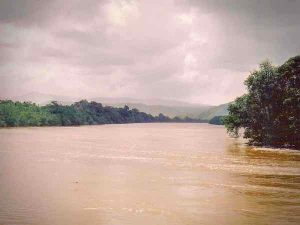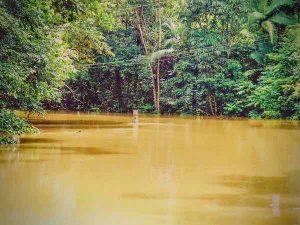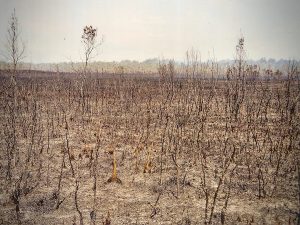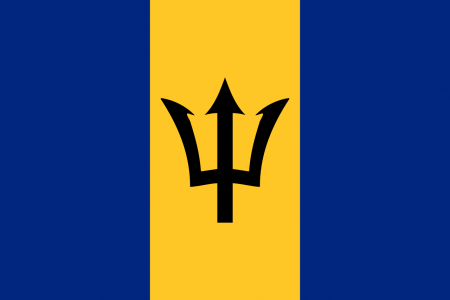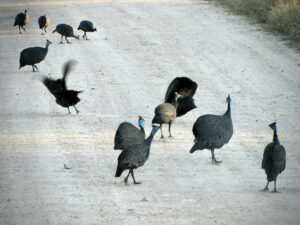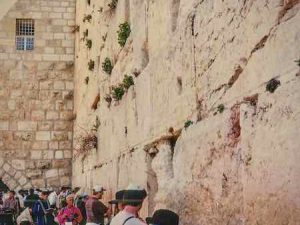Where’s the Funny? Newsletter
Volume 8: 2 June 2020
MURDERLAND: Why does Australia want to kill me?
With all due respect to my friends down under, please stop trying to kill me. Every single time I set foot on your continent, there’s a cyclone. Or a wall of fire. Or a sign on the beach, “Beware of alligators.” Seriously?
On one visit to Jervis Bay (2001) – at Christmas, no less – I am forced to put down my egg nog so that I can climb onto a cottage roof and hose it down as the smoke billows in. This is what would become known as the Black Christmas bushfires.
On another visit, to Cairns (2006), it’s the aftermath of Cyclone Larry – the region’s worst since 1931 – that floods the roads and forces me to turn back on what would have been a drive to the Daintree Rainforest. Note to self: Tropical cyclone season in Australia generally runs from 1 November through 30 April.
But fire and floods were no match for the many things that tried to kill me on a single day near Cairns. All I wanted to do was see some waterfalls. Eight waterfalls, in fact. There’s a little circuit.
The day started innocently enough. Cruising around with my map and rental car. On waterfall number seven, the problems begin. Mind you, to see all these falls, I have to literally jog down the trails – sometimes one or two miles through the rainforest – for the payoff. I’m on a mission!
But here, something is amiss. I reach into my pocket, and to my horror, it’s empty. Except for the hole. My car keys are gone. It’s about 3 pm and there is no cell reception. No AAA. I pass two people on the trail.
“Excuse me, but if you happen to see a set of car keys just laying around on the jungle floor, would you let me know?”
I painstakingly retrace my steps. I’m more than a mile in, and the path is completely covered in foliage and jungle debris. There is no way in hell I am going to find these keys. This is Australia’s first attempt on my life.
But then, a miracle. I approach a short set of stairs on the path. I remember jumping down them. Could that jump have dislodged the keys? I look around the base of the stairs where I landed. It’s all green and brown leaves. But there they are, right where I left them. What are the odds?
I’ve got one more stop, at Emerald Creek. It’s almost 4 pm now, and this last falls is again about 1.5 miles into the canopy. I am at a full sprint now. I cross a creek, slipping into the water briefly. Deeper I go.
The crazy thing about walking in a rainforest is that once your inside, it can get dark awfully fast – especially when the sun is on its way down. About a half mile in, I am losing sight of the trail. It’s all starting to look the same, and it’s all shadows now.
Do I keep going? This is insane. I literally can not see anything now. Come to your senses, man! I stop. I’ve got to turn around, or I will never get out. This is the second attempt on my life, albeit self-inflected.
I turn around and make my way back. The crazy thing is, once I emerge from the canopy, it’s completely and utterly total daylight. Are you kidding?
I casually walk back through some grass to get to my car. I’m not really paying attention, wallowing more in my epic fail to reach that eighth waterfall. Just as I’m about to take another step, I see a mass curled up in the grass. It’s a huge snake, just inches from my feet. If I had not looked down, I would have stepped right on what turns out to be a scrub python (see photo above).
Death by serpent, attempt number three. What else can go wrong.?
I look up into the sky. It’s dusk now and there is a black mass, swirling overhead. What the … ? It’s a swarm of enormous flying fox fruit bats, out for blood. Not mine! Not today! I rush for the car, taking care not to step on any more sleeping pythons. Attempt four.
Finally, I am safe and in the car. I head back to Cairns and the security of my hotel. Once back in my room, I exhale. I’m a mess, so I head for the shower.
As I strip, I see some sort of fleshy mass attached to my ankle, just above my footie. It’s like a tiny balloon. LEECH! And it’s totally engorged – on MY blood. The flying foxes may not have gotten me, but this leech sure did.
Where could I have picked up a leech? Was it that stream at Emerald Creek? I barely stepped in that water. In a panic, I strip. Time for a full body search. And there it is – another one on the back of my thigh.
I don’t have any salt. Or matches. So I resort to carefully plucking the little prehistoric balls of blood off my skin. I throw them in the toilet and flush.
What? NOOOOOOO! They have attached themselves to the porcelain, and even the mad rush of swirling water is not enough to make them go away. I pick them up again, wrap them in toilet paper and flush again. Finally, success.
Good try, Australia, but I am not going to die today.
QUOTE:
“The world is big and I want to have a good look at it before it gets dark.”
– John Muir (1838-1914), naturalist philosopher, “Father of the U.S. National Parks” and, recently, a few other, less flattering monikers
WTF? NEWSLETTER
LISTICLE: 5 THINGS I WILL NEVER EAT (AGAIN)
As the grandson of a butcher – (Fred) Heinz Meats in Cincinnati’s historic Findlay Market – so there have been times where brain has been on the dinner menu at the Grandma’s house in Pleasant Ridge. Sometimes, it’s liver – that was Dad’s favorite – or tongue. Not much went to waste. After all these years, I’m still no foodie. But when on the road, I still gotta eat. Here’s my Top 5 items I hope to never see on the menu again:
- Lobster tartar, with yuzu and hibiscus (Tatar af Jomfruhummer med Yuzu og Hibiscus), at Geist in Copenhagen (2018): Imagine an entire dinner plate covered in a thin, translucent gelatin. The mucus-like app is so flimsy, I’m not sure what utensil to use. How, exactly, does one scrape jelly off a plate? And what, in god’s name, did the chef have to do to turn lobster into this? If you pulverize something long enough, does it eventually turn into this? I must admit, it did at least offer the absolute faintest hint of lobster taste. But for DK$145 (US$22.58)!
- Sea cucumber soup at the Grand Hotel Taipei in Taiwan (2000): Why does every exotic dish in Asia have something to do with male potency? What about female potency? This abomination, served at the iconic, red-everywhere Grand Hotel Taipei, is part of an Arthur Andersen (R.I.P.) business lunch. Do you know what sea cucumbers eat? Algae. Tiny sea creatures. And poop. Thank you very much for your business. At least it wasn’t horseshoe bat. Or pangolin. Maybe that’s the good stuff – only available on the mainland.
- Durian, from a supermarket in Singapore (2001): This spiky, stinky staple of any real Singaporean’s diet is a must for any traveler. If you’re an expat, like I was, your hosts will delight in the horrific faces you make as you bite into the odorous delight. The fruit is so pungent, it’s banned on the Singapore subway (the “MRT,” for Mass Rapid Transit) and in most public spaces. If you like social distancing, durian is the food for you.
- Bone marrow soup, on some muddy, pock marked street, in Dar es Salaam, Tanzania (2010): The only thing you need to know about this streetside food stall experience is that I am on my way to the airport when my driver – a derelict cousin of a good Tanzanian friend – insists that we stop. “Don’t worry! Plenty of time!” he says. There’s just something about being asked to eat a bowl full of bones 15 minutes before my plane is supposed to leave that just ruins the whole dining experience. Luckily, I’m on “Africa time,” and I make the flight.
- Steak tartare, at some nameless Paris bistro near the Sacré-Cœur (2004): When the French aren’t force feeding ducks, they’re eating raw horse meat. I order what I think is a hamburger. Ha! The joke’s on you, ignorant American swine! Imagine my expression when the waiter returns with a pound of ice cold, pinkesh-red raw flesh that looks like it just came out of a circular Jell-O mold. I take a few bites to save face, washing away thoughts of cannibalism with beer (unsophisticate!) and pommes frites.
IN PRACTICUM
ROAD TRIPPIN': There's an (absolutely geeky) app for that – and it's (mostly) free!
I am a man, and one of the many faults related to this condition is my love for the open road. For 30 days in early 2020, it was a 4,983 mile round trip in a rented mini-van from Chicago to Tucson. Call me COVID-19 crazy, but this month I plan to drive another 5,000 mile loop west until I see the end of the road or smoke in the sky – whichever comes first. Let’s just call it my “Not Going to Portland” trip.
I don’t really have a planned route for this trip, but if I wanted to plan one, there are several online tools from which to choose. Mind you, if I have the time, the last place you’ll find me is on the Interstate. It’s great for getting from point A to point B, while having the least amount of fun. But if you want to incorporate multiple stops along the way, here are a few free ideas to help plan your route:
Mapquest: This old, but still good route planner allows you to input up to 26 addresses. You can enter your stops in three ways: 1) Line by line, using the Mapquest system; 2) Cut and paste all the stops at one time (one line per stop, in a particular format); 3) Import a spreadsheet (examples provided). Too many ads can make this one annoying.
Roadtrippers: This Cincinnati-based company, now owned by RV titan Thor Industries, allows only five stops on its free route planner. But what’s compelling is the massive, user-generated database, which shows possible stops across a broad array of categories: Accommodations; Attractions & Culture; Food & Drink; Outdoors & Recreation; Points of Interest; Camping & RV; Entertainment & Nightlife; Services; Shopping; Sports; and, Motoring. Additional filters reside within each category. For example, under Services there are ATMs, Rest Areas, Vehicle Rentals, Gas Stations and more. The paid version ($29.99 per year) allows up to 150 stops, is ad free, offers live traffic views and a few other bells and whistles.
RouteXL: This is an interesting app that stresses route optimization – to save on fuel costs, for example – for multi-stop trips. It’s free for up to 20 stops, with daily and monthly rates (in euros) for up to 100 and 200 stops, respectively. I had a rather complicated trip planned, and it was fun to plug in the random stops and see what route the app recommends. And if you don’t like the results, it’s easy to re-order the stops and try again. Route4Me is another pro-grade route optimizer, but it’s designed (and priced) for business.
Waze: This is a traffic app, not a road trip route planner. But it can be useful within unfamiliar cities, with live traffic and accident updates. Google bought Israel-based Waze in 2013.
Of course, there are Apple Maps (my usual first choice) and Google Maps. But both have limitations when it comes to multi-stop routes. Google, at least, allows up to 10 stops.
QUICK SPINS:
DIGITAL NOMADS: Barbados and other cures for the COVID-19 blahs
Even though I’ve read Tim Ferriss’ The 4-Hour Workweek: Escape 9-5, Live Anywhere, and Join the New Rich, I have never met someone who actually refers to themself as a digital nomad. That all changed last October in Mexico when I met Jessie, a 40-something professional videographer / photographer who lives on the road full-time.
Jessie sold her Chicago condo and now lives in one- to three-month increments wherever in the world there’s an internet connection. Chicago is still home when she needs it, but now usually it’s a friend’s guestroom – no strings attached.
If the gig worker, digital nomad, work-from-home lifestyle appeals to you, then you’ll be glad to hear that several countries recently changed their visa requirements to allow for longer stays. It makes sense, especially for tourism-dependent nations that have seen their economies get crushed by COVID-19.
In June, the Caribbean island of Barbados started to offer a “Welcome Stamp,” which allows the location independent to work remotely on the island for up to 12 months. Applications are usually approved within five business days, at a cost of US$2,000 for individuals and US$3,000 for families.
For only US$263, you can apply for a 12-month Work from Bermuda certificate. That’s seems cheap until you learn that Bermuda is one of the most expensive places to live in the world, according to the World Population Review. The expat cost comparison website Expatistan.com says a single person will spend about US$5,225 per month to live there.
Others who recently introduced special “freelancer” visas include Estonia, Mexico, Czech Republic, Portugal and Mexico. All I can say is, do your research. Or you may just end up working twice as hard to pay your bills and get back home – wherever that may be.
CARTOON: It's BLIP!
TRAVEL IN TURMOIL: The latest ...
As the rules and conditions around COVID-19 era travel continue to evolve, what’s a tourist to do? The mayor of Rio de Janeiro has closed their iconic beaches until there’s a vaccine (or a new beach reservations app). Lovers of King Tut will have to wait another year for the opening of the fabulous Grand Egyptian Museum in Cairo. The easy answer is to just stay home. But for those who dare to venture out, here are a few timely travel updates:
- Oh, Canada: The border with Canada remains closed to non-essential travel at least through September 21. It’s been closed since March 18, although I’m sure there are plenty of scofflaws who say, “But we’re driving to Alaska.”
- Stop touching me! Vacant middle seats and capacity limits are falling by the wayside on some major U.S. airlines. Cash-strapped American dropped its capacity restraint (set at 85 percent) on July 1, while nearly bankrupt for the umpteenth time United never instituted a limit. Instead, United books windows and aisles first – then middle seats. And if you don’t like it, you can roll the dice and change flights (for free) … again and again and again, until you don’t want to go on your trip anymore. At the other end of the spectrum is Delta, which has vowed to keep middle seats open all the way until January 6, although it will raise its capacity limit from 60 to 75 percent through October 31 – when it also will review its policies. Southwest says it will block middle seats until at least October 31.
- Cruisin’ for COVID-19: Tourists undeterred by past diarrhea epidemics will have to wait until at least October 31 to board another floating shitty … uhh, city … in U.S. waters, according to the Cruise Lines International Association. The industry trade group doesn’t want to mess with the CDC-imposed ban, which (at the moment) ends September 30. The solution? If you’re absolutely dying (figuratively speaking) to take a cruise, just do it outside of U.S. territory.
- Now wait just a(nother) minute! On August 7, the U.S. State Department lifted its March 19 blanket “do not travel” warning on all international destinations in favor of the usual, more specific country-by-country advisories. But don’t plan on hopping that flight to Europe just yet, as the EU still has a ban in place on travelers from the United States.
WHO COOKS FOR YOU? Birders go berserk for watch data website
OK, I admit it. Decades ago, I may have said “bird watching is boring” or “bird watchers are boring” or “watching birds instills boredom.” Something to that effect. I can hear it now: ORNITHOPHOBE!
Well, all you boring birders out there will be happy to learn that I have found religion. It took trips to Brasil and South Africa to wake up, but consider me fully woke! Birds are amazing. They prance and preen. They eat ticks off cows. The bathe in dirt. I repeat. They bathe in dirt! And did I mention, some of them can even fly?
Birds are so cool and complex, it takes a bunch of Ivy Leaguers at the Cornell Lab of Ornithology to create an app that basically crowd sources bird population and migration data. Using eBird.org, birders can easily upload what they see (and hear) and when and where they see it into one massive database. When combined with satellite imagery from NASA, the data – more than 500 million entries so far – helps educators and scientists understand bird species movements and distributions like never before. So, now you not only have a fun way to track your sightings, but also a way to help conservationists. Now that’s something to crow about!
Read about a few groovy birds spotted on safari at Kruger National Park, South Africa
PHOTASTIC! Old City of Jerusalem and Bethlehem
As an associate editor at HOTELS magazine in 1997, an extremely rare (free) FAM (“familiarization”) trip takes me on an 8-day, whirlwind tour of Days Inn franchisees in Israel. I manage to squeeze in a tour of the walled Old City of Jerusalem, Bethlehem and Yad Vashem, Israel’s Holocaust memorial and museum – a complex would quintuple in size in 2005, making it almost unrecognizable to me now.
The trip is remembered most not for my 4 am encounter with an Israeli mercenary (“working” in Central Africa) or Tel Aviv’s “last-day-on-earth” vibe. Or the dip in the Dead Sea or burned-out school bus outside Bethlehem. It’s not even my visit to the Church of the Nativity, which many believe to be the birthplace of none other than Our Lord and Savior Jesus Christ. What could possibly top that? Drum roll, please. A ticket to a private, poolside concert by the one and only Sir Tom Jones (!), who wooed and wowed an absolute Who’s Who of Israeli celebrities at a new beachside resort in Eilat. It would take another 15 years for Jones to return to Israel, so while you might think “It’s not unusual” – his 1997 performance in Israel really was.
QUESTIONS OR COMMENTS?
First, thank you for reading this newsletter. If you have any questions about anything that appears here, please do not hesitate to contact me directly via email at: hello@wheresthefunny.blog.
PREVIOUS NEWSLETTERS
- Where’s the Funny? Volume 1 (November 2019)
- Where’s the Funny? Volume 2 (December 2019)
- Where’s the Funny? Volume 3 (January 2020)
- Where’s the Funny? Volume 4 (February 2020)
- Where’s the Funny? Volume 5 (March 2020)
- Where’s the Funny? Volume 6 (April 2020)
- Where’s the Funny? Volume 7 (May 2020)



